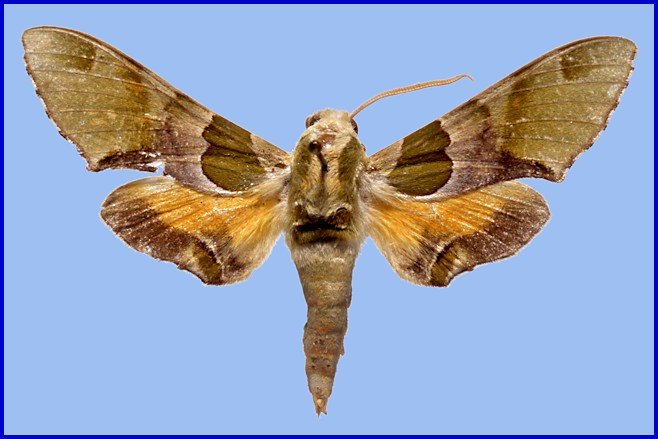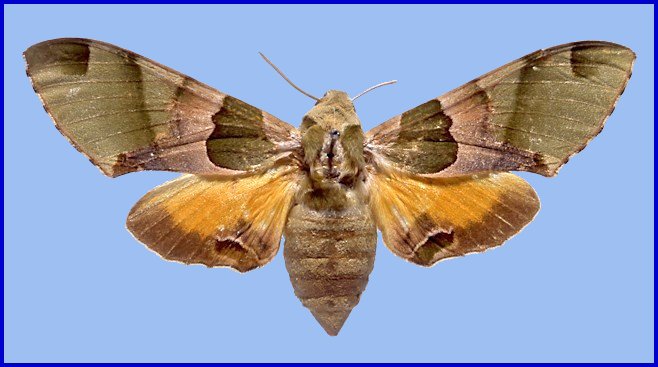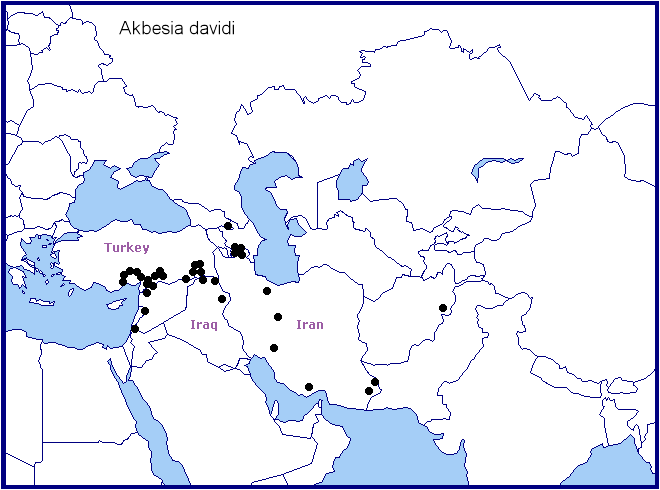UK: Pistacia Hawkmoth
Akbesia davidi gandhara De Freina & Geck, 2003, Nachr. entomol. Ver. Apollo, N.F. 23(4): 178.Type locality: Eastern Afghanistan, Sarobi, 1100m, 25.v.1961.
(Taxonomic note. Based on phenotypic and genitalial differences, specimens of the nominate subspecies (Akbesia davidi davidi) from southeast Republic of Georgia, southern Armenia, Azerbaijan and the western Alborz Mountain range (Iran) were separated out as a new subspecies, namely Akbesia davidi hofmanni De Freina & Geck, 2018. These exhibited some characters that indicated a closer relationship to Akbesia davidi gandhara. However, although some individuals from northern Iran and Azerbaijan resembled this subspecies (De Freina & Geck, 2003; 2018), others appeared to be intermediate between Akbesia davidi gandhara and Akbesia davidi davidi. This region may thus represent a suture zone between what were formally separated populations.)
Holarctic; western Palaearctic region. Pleistocene refuge: Monocentric -- unclear, probably monocentric in the eastern half of the Iranian refuge, or Afghan subsection of the Turkestan refuge, or the Iranoeremic refuge.


Wingspan: 65--80mm. Noticably larger than Akbesia davidi davidi (Oberthür, 1884), with the green coloration of that subspecies more greyish. Dorsal surface of thorax not olive-green but, except for the tegulae, pale greyish-olive. Forewing upperside with a larger basal area; basal spot less pronounced. Discal area wider, more strongly rosy-lilac to pale purple in colour. Sub-basal dark patch not joined to the inner margin of the wing. Hindwing upperside with a broad dark submarginal band. Anal 'eye-spot' more pronounced, with a strongly curved inner white margin. The underside of both wings is noticably paler than in Akbesia davidi davidi, more greyish-green, with a less intense reddish-brown centre to the forewing (De Freina & Geck, 2003).
Although a local species, it often occurs in large numbers at certain sites in rocky, hilly areas supporting scattered trees and shrubs of Quercus, Olea, Ceratonia and Pistacia.
Probably bivoltine, but all individuals to date have been captured between 25 May and 3 June (De Freina & Geck, 2003).
OVUM: Unknown, but probably the same as for Akbesia davidi davidi.
LARVA: Unknown, but probably the same as for Akbesia davidi davidi.
Hostplants. Unknown, but probably the same as for Akbesia davidi davidi.
PUPA: Unknown, but probably the same as for Akbesia davidi davidi.
None recorded.
So far, only recorded from around Sarobi, eastern Afghanistan at 1100m altitude (De Freina & Geck, 2003). It may also occur (more widely) across northern and central Afghanistan and into Pakistan, as the vegetation zones in these areas are similar to those around Sarobi.
Extra-limital range. None.

Southern Turkey (Oberthür, 1884; Daniel, 1939; De Freina & Geck, 2003; Feza Doganlar, pers. comm.), northern Syria (De Freina & Geck, 2003), northern Israel (D. Benyamini, pers. comm.; Müller et al., 2005b), western Jordan (Müller et al., 2005a), south-eastern Turkey (De Freina & Geck, 2003), north-eastern Iraq (Wiltshire, 1957), southeastern Republic of Georgia (Naumann & Zolotuhin, 2000), northern Iran (Alborz Mountains) (De Freina & Geck, 2003), the Zagros Mountains of western Iran (Boyer-Ahmad, Kohgiluyeh Province, 20-24.v.2011; Ghassemi, Alemansoor & Alehossein, 2010) and Iranian Beluchistan (Barou, 1967) as Akbesia davidi davidi.
 Return to species list
Return to species list